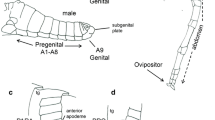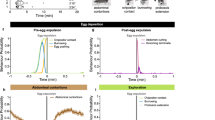Summary
-
1.
Central pathways for bag cell activation were identified by examining the frequency of spontaneous egg laying episodes in animals with central connective lesions. Bilateral lesions of the cerebropleural (but not the cerebropedal) connectives abolished spontaneous egg laying. In contrast, bilateral lesions of all cerebral ganglion peripheral nerves did not abolish spontaneous egg laying, suggesting that sensory input to the cerebral ganglion is not necessary for activating the bag cells.
-
2.
Backfilling either pleuroabdominal connective labelled cell bodies in the cerebral ganglia (via the ipsilateral cerebropleural connective) that could project to the bag cells. Focal extracellular stimulation of these stained clusters activated the bag cells in isolated brains.
-
3.
Central pathways for initiating egg laying behaviors were identified by selectively eliciting bag cell discharges in animals with central connective lesions. Bilateral lesions of the cerebropedal (but not the cerebropleural) connectives completely abolished elicited egg laying behaviors.
-
4.
Pathways for motor output during rhythmic head and neck movements were identified by eliciting bag cell discharges in animals with peripheral nerve lesions. Bilateral lesions of the four tegumentary nerves in combination with the anterior pedal nerve completely abolished elicited egg laying behaviors, indicating that these nerves are necessary for normal motor output. A normal pattern of egg laying behaviors occurred when the four tegumentary and the anterior pedal nerves were left intact and all other pedal ganglion nerves were lesioned bilaterally, indicating that these nerves are also sufficient for normal motor output.
-
5.
We conclude that i) the cerebropleural connectives are necessary for initiation of spontaneous bag cell discharges but not egg laying behaviors, ii) the cerebropedal connectives are necessary for initiation of egg laying behaviors but not bag cell discharges, and iii) the motor output for egg laying behaviors is distributed through a limited number of pedal ganglion nerves.
Similar content being viewed by others
Abbreviations
- ASW :
-
artificial sea water
- CDCs :
-
caudo-dorsal cells
- CNS :
-
central nervous system
- ELH :
-
egg laying hormone
References
Arch S, Smock P (1977) Egg-laying behavior inAplysia californica. Behav Biol 19:45–54
Chiu A, Strumwasser F (1984) Two neuronal populations in the head ganglia ofAplysia californica with egg-laying hormone-like immunoreactivity. Brain Res 294:83–93
Cobbs JS, Pinsker HM (1982a) Role of bag cells in egg deposition ofAplysia brasiliana: I. Comparison of normal and elicited behaviors. J Comp Physiol 147:523–536
Cobbs JS, Pinsker HM (1982b) Role of bag cells in egg deposition ofAplysia brasiliana: II. Contribution of egg movement of elicited behaviors. J Comp Physiol 147:537–546
Ferguson GP, Ter Maat A, Pinsker HM (1986a) Organization of egg-laying behaviors in intactAplysia. Soc Neurosci Abstr 12:360
Ferguson GP, Parsons DW, Ter Maat A, Pinsker HM (1986b) Spontaneous and elicited bag cell discharges in gonadectomizedAplysia. J Exp Biol 123:159–173
Ferguson GP, Ter Maat A, Pinsker HM (1987) Organization of egg-laying behaviors inAplysia. In: Boer HH, Geraerts WPM, Joosse J (eds) Neurobiology, Molluscan Models. Monogr Kon Ned Akad Wetensch. North Holland, Amsterdam, pp 248–254
Ferguson GP, Ter Maat A, Parsons DW, Pinsker HM (1989) Egg laying inAplysia: I. Behavioral patterns and muscle activity of freely behaving animals after selectively elicited bag cell discharges. J Comp Physiol A 164:835–847
Fredman SM, Jahan-Parwar B (1983) Command neurons for locomotion ofAplysia. J Neurophysiol 49:1092–1117
Haskins JT, Blankenship JE (1979) Interactions between bilateral clusters of neuroendocrine cells inAplysia. J Neurophysiol 42:356–367
Jahan-Parwar B, Fredman SM (1976) Cerebral ganglion ofAplysia: cellular organization and origin of nerves. Comp Biochem Physiol 54A:347–357
Jansen RF (1983) Neuronal and hormonal control of the egglaying behavior in the pond snailLymnaea stagnalis. Ph D thesis, Vrije Universiteit, Amsterdam
Jansen RF, Ter Maat A (1985) Ring neuron control of columellar motor neurons during egg-laying behavior in the pond snail. J Neurobiol 16:1–14
Kandel ER (1979) Behavioral biology ofAplysia. Freeman, San Francisco
Kupfermann I (1974) Dissociation of appetitive and consummatory phases of feeding behavior inAplysia: a lesion study. Behav Biol 10:89–97
Mackey S, Carew TJ (1983) Locomotion inAplysia: triggering by serotonin and modulation by bag cell extract. J Neurosci 3:1469–1477
Painter SD, Rock MK, Blankenship JE (1983) Lesion studies indicate possible sites of atrial gland extracts for inducing bag cell afterdischarge inAplysia. In: Lever J, Boer HH (eds) Molluscan neuro-endocrinology. Monogr Kon Akad Wetensch, North Holland, Amsterdam, pp 91–92
Parsons DW, Pinsker HM (1988) Swimming inAplysia brasiliana: identification of parapodial opener-phase (POP) and closer-phase (PCP) neurons. J Neurophysiol 59:717–739
Parsons DW, Ter Maat A, Pinsker HM (1983) A technique for selective recording from individual identified neurons in intact freely-behavingAplysia. Science 221:1203–1206
Pinsker HM, Dudek FE (1977) Bag cell control of egg laying in freely behavingAplysia. Science 197:490–493
Pinsker HM, Parsons DW (1985) Temperature dependence of egg laying inAplysia brasiliana andA. californica. J Comp Physiol B 156:21–27
Porten KP von der, Parsons DW, Rothman BS, Pinsker HM (1982) Swimming inAplysia brasiliana: analysis of behavior and neuronal pathways. Behav Neural Biol 36:1–23
Porten KP von der, Redmann G, Rothman B, Pinsker HM (1980) Neuroethological studies of freely swimmingAplysia brasiliana. J Exp Biol 84:245–257
Quicke DLS, Brace RC (1979) Differential staining of cobalt- and nickel-filled neurons using rubeanic acid. J Microscopy 115:161–163
Stuart DK, Strumwasser F (1980) Neuronal sites of activity of a neurosecretory peptide, egg laying hormone, inAplysia californica. J Neurophysiol 43:499–519
Vlieger TA de, Kits KS, Ter Maat A, Lodder JD (1980) Morphology and electrophysiology of the ovulation hormone producing neuro-endocrine cells of the freshwater snailLymnaea stagnalis. J Exp Biol 84:259–271
Author information
Authors and Affiliations
Additional information
Deceased
Rights and permissions
About this article
Cite this article
Ferguson, G.P., Ter Maat, A. & Pinsker, H.M. Egg laying inAplysia . J. Comp. Physiol. 164, 849–857 (1989). https://doi.org/10.1007/BF00616756
Accepted:
Issue Date:
DOI: https://doi.org/10.1007/BF00616756




